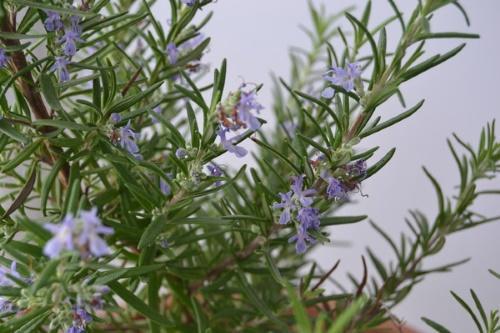How to grow rosemary - the subtleties of gardening
 Rosemary in our area is not so rare. Although it is a thermophilic crop, the spicy herb has also taken root in our climate and is doing quite well. Of course, cold winters dictate their terms. However, if you know some of the subtleties of how to grow rosemary, even a novice gardener can get this plant. So, what should you pay attention to if you decide to plant these fragrant bushes? Before you go shopping for planting material, you should think about where it will grow and what rosemary will need. But let's talk about everything in order.
Rosemary in our area is not so rare. Although it is a thermophilic crop, the spicy herb has also taken root in our climate and is doing quite well. Of course, cold winters dictate their terms. However, if you know some of the subtleties of how to grow rosemary, even a novice gardener can get this plant. So, what should you pay attention to if you decide to plant these fragrant bushes? Before you go shopping for planting material, you should think about where it will grow and what rosemary will need. But let's talk about everything in order.
How to grow rosemary - sowing and cutting

Like most horticultural crops, rosemary is sown in two ways:
- directly into open ground;
- first for seedlings.
However, it should be borne in mind that seeds need stable heat for germination. In addition, full-fledged lush bushes in the first case will form only by autumn. Thus, in order not to waste precious time, it is better to plant rosemary in a seedling way.
Seeds for seedlings are sown in early March. In early April, seedlings dive into separate containers. When the frosts pass, the seedlings are planted in the garden. In this case, it is necessary to leave enough free space between the bushes (about 40 cm), otherwise it will be cramped for them.
When the beginning of the rosemary beds is laid, it can be propagated by cuttings. At the end of June, young twigs up to 10 cm long are cut and rooted in the soil. Such bushes grow quickly and will delight you with fragrant greens already this season.
Some features of growing and caring for rosemary
Of course, strong and healthy seedlings are one of the main factors in producing a lush plant. But it will not be enough if you do not take into account the requirements of the culture to the soil and planting site. A native of southern countries, rosemary prefers sunny warm areas that are not blown by the wind. In the shade and in a draft, even the most powerful seedlings will turn into a pitiful likeness of bushes.
Rosemary will not grow in heavy clay soil, as well as in acidic soil. He needs a nutritious and loose substrate, preferably based on black soil, sand and peat in equal proportions. It's a good idea to add some lime to it.
 You also need to be careful with watering rosemary bushes and find a middle ground. They will not forgive excess moisture and shed the foliage, and in the dry ground the leaves will remain, but turn yellow. In the spring, plants can be fed with nitrogen fertilizers - they will help build up a lush green mass. Then use mineral complexes once a month.
You also need to be careful with watering rosemary bushes and find a middle ground. They will not forgive excess moisture and shed the foliage, and in the dry ground the leaves will remain, but turn yellow. In the spring, plants can be fed with nitrogen fertilizers - they will help build up a lush green mass. Then use mineral complexes once a month.
 And, perhaps, the most important nuance is the wintering of garden rosemary. By its nature, it is a perennial, and if the winters are warm in your area, the bushes will be able to overwinter. The only thing is that the shelter will still help keep most of the landings.In colder regions, rosemary is commonly grown as an annual, sowing seeds annually. However, there is another option - to plant in pots and dig in the garden with them. For the winter, the pots will have to be taken to a cool room, but next spring no seedlings are needed.
And, perhaps, the most important nuance is the wintering of garden rosemary. By its nature, it is a perennial, and if the winters are warm in your area, the bushes will be able to overwinter. The only thing is that the shelter will still help keep most of the landings.In colder regions, rosemary is commonly grown as an annual, sowing seeds annually. However, there is another option - to plant in pots and dig in the garden with them. For the winter, the pots will have to be taken to a cool room, but next spring no seedlings are needed.